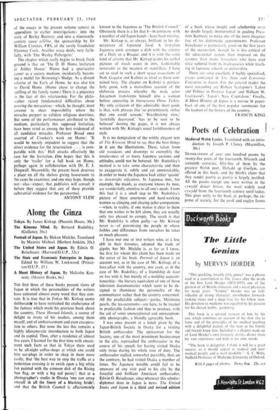Along the Ginza
Portrait of Japan. By Hakon Mielche. Translated
Reischauer. (Harvard/O.U.P., 52s.)
A Short History of Japan. By Malcolm Ken- nedy. (Mentor Books, 6s.) THE first three of these books present views of Japan in which the personalities of the writers have coloured almost every word that they con- tain. It is true that in Tokyo Mr. Kirkup seems deliberate* to have restrained the exuberance of the fantasy which made his previous book about the country, These Horned Islands, a source of delight to many of his readers, among them myself, and of embarrassment and even exaspera- tion to others. But none the less this remains a highly idiosyncratic introduction to both Japan and its capital. Thus, after a residence of almost five years, I learned for the first time with amaze- ment such facts as that in Tokyo there used to be all-night coffee-shops at which one could hire ear-plugs in order to sleep in them more easily; that `the best way to stop the traffic at a pedestrian crossing is to swish open a big white fan painted with the crimson disk of the Rising Sun flag, or with a big red peony'; that at a photographer's studio in Otsuka 'one can array oneself in all the finery of a blushing bride'; and that the British Council is affectionately
known to the Japanese as 'The Brutish Council.' Obviously there is a lot that I—in company with a number of old Japan hands—have been missing.
Mr. Kirkup is, as always, brilliant in his de- scriptions of Japanese food. A first-class Japanese cook arranges a dish with the artistry of a Dufy or a Braque; and it is with the same kind of artistry that Mr. Kirkup paints his verbal pictures of meals eaten in inns, fashionable resturants or the meanest of stand-bars. I have yet to read in such a short space evocations of Noh, Gagaku and Kabuki as vivid as those con- tained here. The chapter on Kabuki is particu- larly good, with a marvellous account of the elaborate process whereby the male actor Jakaemon transforms himself into a woman before appearing in Imoseyama Onna Teikin. My only criticism of this admirable short guide is that, with phrases like 'so pretentiously shibui that one could scream,' breathtaking view,' 'tastefully decorated,' has to be seen to be believed' dotting the pages, it is not always written with Mr. Kirkup's usual fastidiousness of style.
It is no denigration of the wittily elegant text of The Kimono Mind to say that the best things in it are the illustrations. These, taken from old woodcuts and drawings to exemplify the timelessness of so many Japanese customs and attitudes, could not be bettered. Mr. Rudofsky's method is to take some characteristic and then to exaggerate it, subtly and yet unmistakably, in order to make the Japanese look either 'quaint' or downright ridiculous. In Japanese inns, for example, the maids, as everyone knows by now, are wonderfully attentive to all one's needs. From this fact it is a small step to Mr. Rudofsky's picture of these courteous and hard-working women as clinging and cloying jailer-companions —when, in reality, if one makes it clear to them that one wishes to be left alone, they are usually only too pleased to comply. The result is that Mr. Rudofsky is often guilty—as Mr. Kirkup never is—of patronising the people in whose foibles and differences from ourselves he takes so much pleasure.
I have met one or two writers who, at a low ebb in their fortunes, adopted the trade of gigolo, but Mr. Mielche is, as far as I know, the first for whom this claim has been made on the cover of his book. Portrait of Japan is an account not, as in the case of Mr. Kirkup, of a love-affair with the country, nor even, as in the case of Mr. Rudofsky, of a friendship de haul en bas with it, but merely of a nodding acquain- tanceship—the literary equivalent of one of those television documentaries which seem to be de- signed to illuminate the personality of the commentator rather than the country concerned. All the predictable subjects—geisha, Mikimoto pearls, the tea-ceremony—are here, to be treated in predictable fashion and thus to produce, with the aid of some unexceptional and unexception- able photographs, a blandly agreeable book.
I was once present at a lunch given by the Japan-British Society in Osaka for a visiting British ambassador. The spokesman for the Society, one of the most prominent businessmen in the city, reproached the ambassador in the course of his speech for having visited Osaka only twice during his whole tour of duty. The ambassador replied, somewhat peevishly, that, on the contrary, he had visited Osaka a number of times. No Japanese notable could fail to be unaware of any visit paid to his city by the forceful and brilliant American ambassador, Edwin 0. Reischauer, since whatever this scholar- diplomat does in Japan is news. The United States and Japan is a third and revised edition of a book whose insight and scholarship were no doubt largely instrumental in guiding Presi- dent Kennedy to make one of the most imagina- tive of his diplomatic appointments. Professor Reischauer is particularly good on the first years of the occupation, though he is less critical of the educational system then imposed on the country than many foreigners who have ever since suffered from its inadequacies while teach- ing in Japanese schools or universities.
There are some excellent, if highly specialised, essays contained in The State and Economic Enterprise in Japan. For the general reader the most rewarding are Robert Scalapino's 'Labor and Politics in Postwar Japan' and William W. Lockwood's 'Japan's New Capitalism.' Finally, A Short History of Japan is a reissue in paper- back of one of the best popular summaries for the layman of the history of the country.
FRANCIS KING


































 Previous page
Previous page